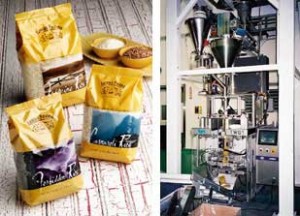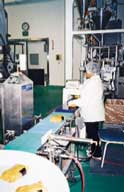Senba – Vertical Form/Fill/Seal Packing Line

Dual filler hoppers on a vertical form/fill/seal machine at contract packer Senba USA combine auger and volumetric cup units to run a variety of products.
Senba USA, Inc., Hayward, CA, specializes in private-label operations. Opened in 2001, the U.S. plant of Japanese food giant Senba Foods Co., Ltd., specializes in manufacturing Asian food products for retail, wholesale, foodservice and industrial users. The facility is QAI Organic and kosher-certified. One of the primary packaging lines at the plant utilizes a Model TWB1 vertical form/fill/seal machine from Tokyo Automatic Machinery Works, Ltd., which is represented in the U.S. by Doboy. The line was installed and system integration was provided by Millennium Mechanical.
The vf/f/s machine is equipped with a dual-hopper filler from Spee-Dee Packaging Machinery that combines a Spee-Dee 3500 Digitronic auger with a volumetric cup filler, which consists of a rotary indexing disc containing several cups to dispense product. Both units are controlled by a programmable logic controller located in the electrical enclosure and a single touchscreen, and both feature EcoDrive digital AC servo systems to precisely control speed and position of the MKD rotary servo motors with high-resolution feedbacks. All are provided by Bosch Rexroth Corp. The dual hoppers enable Senba to fill two different products into one pouch simultaneously, which provides the advantage of blending the components as they are filled rather than layering them into the bag in separate steps. This system was originally installed to run pancake mix and chocolate chips, with the pancake mix dispensed by the auger and the chocolate chips by the cup filler.
The auger and cup fillers are installed as standalone units that are integrated with the bagging machine controls. Synchronization of the two filling systems with the bagging machine is critical, especially at higher operating speeds, when differences between the rate of fall of the two components, such as rice and spices, down the tube into the bag can cause difficulties. Product is transported to the overhead hoppers by Eriez vibrating conveyors.
During PD’s visit, the line was running 2-lb bags of Organic Jasmine rice for Lotus Foods, Inc. The bagger initiates each machine cycle by sending the filler a request for product. This triggers the auger and/or cup filler to dispense product, which drops down the tube into the bagger. Film is mounted on the back of the machine and is pulled over dancer rollers for tension control. It then passes over the top of the machine and is pulled down around the forming collar and past the vertical seal bar by two pull belts. The belts move inward and hold the film against the fill tube as they draw the film downward during the motion part of the cycle. They then move away from the tube during the stationary part of the cycle as product is filled.
After the filler discharges the product, it sends the bagger a “dump-confirm” signal, verifying that it has received a request from the bagger, and that it has responded by dumping product. This lets the filler know that it is safe to begin pulling film. This exchange of signals, or “handshaking” between the bagger and the auger allows the bagger to operate in an ³on-demand² mode of operation, which means that if the filler does not dispense product, film will not be pulled and a package will not be created.
As the film pull is being completed, the bagger end-seal mechanism begins to close. The film pull and the closing of the end-seal mechanism are timed so that they overlap slightly. In other words, the sealing jaws begin to close as the film is in motion, but do not come to a closed position until the film has stopped its motion. This reduces the time to complete each machine cycle, so there is a potential for a higher rate of production. As the end seals come together, they remain closed for the specified amount of time required to heat seal them together. As the seals are being created, a knife is actuated to separate the newly formed package from the package above it.
The bagger can save up to 48 different product setups that include operating parameters such as timing and temperature settings. Access to these setups, which is done through a touch-sensitive operator interface, greatly reduces the time required to change over the machine to run different products. The operator interface also allows operators to gain access to machine performance data such as production statistics and I/O status from the controller.
From the vf/f/s, product is conveyed through a Metalchek 9 metal detector and a CK2500 checkweigher, both from Lock Inspection Systems, Inc. The CK2500 checkweigher is a very sensitive digital weighing system with a 1/2- to 1-g accuracy. Designed for maximum flexibility, the unit retains speeds and other operating settings in memory for a wide range of products. They can be recalled at the touch of a button. It also retains comprehensive statistical data in memory, and can transmit this data to a central reporting station.
While not connected directly to the production line, Senba maintains a standalone Model 15DBC105 cartoner from Adco Manufacturing for use when cartoning is required by a customer. The 15DBC105 is a continuous-motion, auto-load cartoner with fully adjustable infeed and transfer-conveyor pockets. It has an extended size range and variable speed range of 50 to 125 cartons/min. Features include a two-head rotary carton feeder, a 4-ft horizontal powered carton hopper, and no-product/no-carton and no-carton/no-load features. The automatic product inserter features an adjustable overload sensor system with an automatic retraction feature. The cartoner is equipped with a Nordson Corporation hot-melt applicator.


